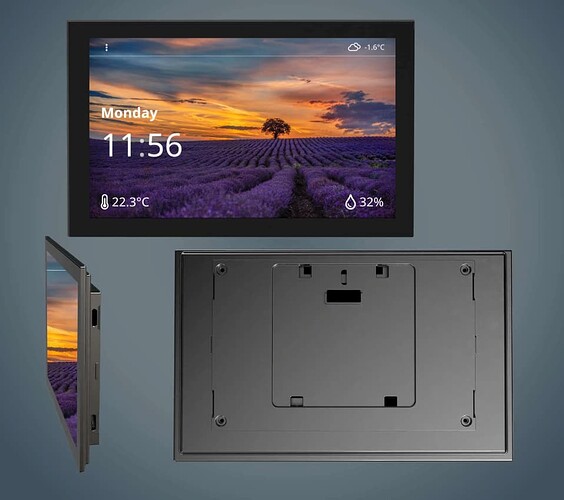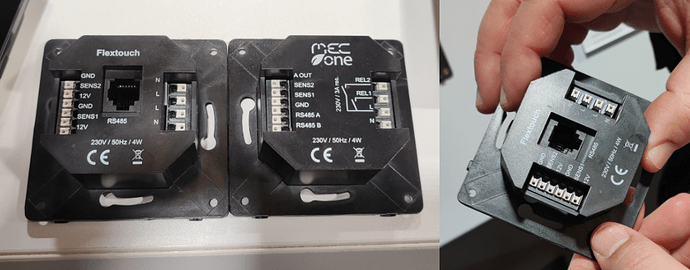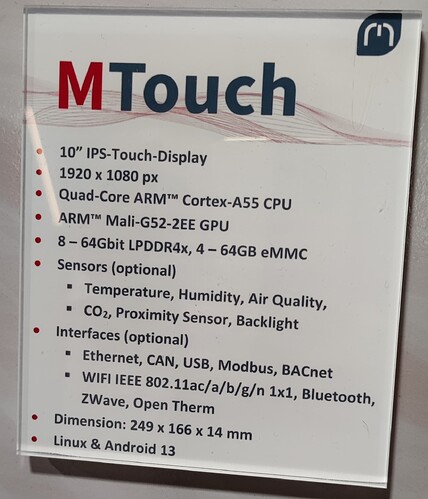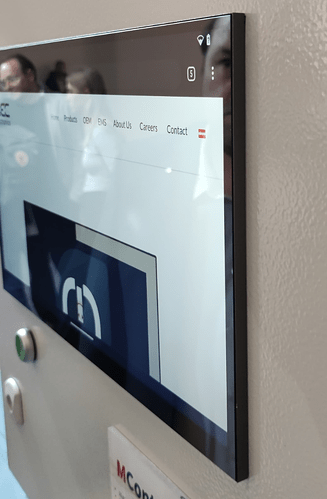JETZT NEU ARTIKEL: ALL-in-One: Tablet und Server für intelligentes Wohnen mit Home Assistant
Jetzt ist eine sehr leistungsstarke Alternative in unserem Shop:
![]() 8’’ Small PoE Display: Touch Display Tablet 8 Zoll PoE mit 2GB/16GB, RK3566 Android 11, Unterputzdose | SLR-8-poe-wall
8’’ Small PoE Display: Touch Display Tablet 8 Zoll PoE mit 2GB/16GB, RK3566 Android 11, Unterputzdose | SLR-8-poe-wall
![]() 14’’ PoE Tablet’n Server: Home Assistant Tablet’n Server - 14 Zoll All-in-One Gerät mit PoE | SLR-AIO14poe-wall
14’’ PoE Tablet’n Server: Home Assistant Tablet’n Server - 14 Zoll All-in-One Gerät mit PoE | SLR-AIO14poe-wall
Ist das Display von MEC ELECTRONICS die Antwort auf viele Fragen im Smart Home Bereich?
Ich denke, ja. Denn die Geräte sind sehr durchdacht, hochwertig verarbeitet und haben ein sehr ansprechendes Design.
Was ist besonders
Touchscreen Bedieneinheit
Der Touchscreen ist mit einem leistungsstarken Chip ausgestattet und kann sowohl mit Linux als auch mit Android betrieben werden. Auf der Light and Building 2024 zeigte man mit einer Variante, auf der Home Assistant direkt „auf dem Display“ installiert war. Das hat natürlich meine Aufmerksamkeit geweckt, denn in diesem Fall wird kein weiterer Server wie z.B. ein Raspberry Pi, Intel NUC oder ähnliches benötigt. Es ist also Smart Home Bedieneinheit und IoT Server in einem Gerät.
Durchdachte Wandeinheit und Display Halterung
Doch damit nicht genug. Das Display ist für die Wandmontage gedacht und benötigt ein entsprechendes Unterputzgerät unter anderem für die Stromversorgung sowie den Zugang zum Netzwerk über LAN. In dieses Unterputz Gerät kann MEC ELECTRONICS optional noch weitere Features auf Wunsch einbauen.
Eingebaute Relays & Sensoren
Die gezeigte Wandeinheit ist mit zusätzlichen Aktoren und Sensoren ausgestattet. Die beiden Relais können dann also zur Steuerung von Lampen, Rollläden oder der Heizung genutzt werden. Es gibt zudem noch Eingänge von Sensoren, wie zum Beispiel Temperatur, Luftfeuchtigkeit, Luftqualität, CO2, Lichtintensität, etc., die man entsprechend den Projektanforderungen individuell einsetzen kann.
Unterschiedliche Größen
Die multifunktionalen Displays sind in unterschiedlichen Größen verfügbar:
4″, 5″, 7″, 10″ IPS-Display
Die Wandeinheit bleibt für die Displays allerdings gleich, sodass man auf Kundenwunsch auch im Nachhinein ein größeres Display eingesetzt werden kann. (Nur bei dem 10-Zoll-Display benötigt man aufgrund der Stabilität eine andere Wandeinheit).
Anpassbare Oberfläche
Die Oberfläche kann auf jegliche Anforderungen angepasst werden. Hier im Video zu sehen, die Variante als komplette Raum-Kontroll-Einheit, mit der die Temperatur geregelt und die Beleuchtung gesteuert wird. Auch werden diverse Sensoren auf der Oberfläche angezeigt und das Bedienkonzept mit den Wischgesten finde ich sehr intuitiv.
In dem Video der hinweis, dass hier Apple HomeKit integriert wurde und die farbige LED Lampe über Z-Wave angesprochen wird!
Besonders Flaches Design
Die Variante mit dem sehr flachen Design hat mir besonders gut gefallen und ich kann mir dieses Display sehr gut im gehobeneren Wohnungsbau vorstellen. Auf der Messe wurde es gezeigt, wie es als Bedieneinheit für einen Industriellen Schaltschrank genutzt wird.
Ebenfalls erhältlich mit integrierter Smart Home Zentrale
Absolut revolutionär ist auch, dass man auf Wunsch der Wandeinheit eine Smart Home Standard hinzufügen kann und so das Gerät in eine vollwertige Smarthome-Zentrale verhandeln kann. Auf der Messe wurde die Z-Wave Variante gezeigt. Es gibt aber auch Ausführungen für DALI, KNX und Open Therm. Es ist aber auch denkbar, dass in Zukunft Zigbee und natürlich auch Matter unterstützt werden.
Meine Empfehlung ist die Variante mit Z-Wave zu verwenden, da dieser Standard über die letzten 10 Jahre entwickelt wurde und entsprechend sehr zuverlässig sowie ausgereift ist. Auch das Debuggen von größeren Z-Wave Netzwerken ist hier mit professionellen Software-Werkzeugen möglich. Ähnliche „Werkzeuge“ gibt es für Zigbee noch nicht oder nur selten.
Im Detail
Smart Home Hardware
In der Wandeinheit ist ein Z-Wave Chip verbaut. Dieser Z-Wave Chip dient als zentrales Steuer und Koordinierung Element aller weitere Z-Wave Geräte wie z.B. Zwischenstecker, Dimmer, Rollladenschalter, Türsensoren etc.
Kommunikation mit Home Assistant
Home Assistant ist vor kurzem der Z-Wave Allianz beigetreten: Nabu Casa joins the Z-Wave Alliance - Home Assistant. Entsprechend einfach ist dann auch die Einrichtung, denn der Z-Wave Chip wird automatisch von dem System erkannt und ist mit wenigen Klicks einsatzbereit.
Weitere Z-Wave Geräte hinzufügen
Dank QR Smart Start ist Z-Wave ein sehr Systemintegrator freundlicher Standard und das Anlernen neuer Geräte ist auch aus der Ferne möglich.
Steuerung und Automationen
Die Steuerung und das Erstellen von Automationen, Skripten sowie Szenen etc. geht dann nahtlos über Home Assistant. Die neuen Geräte sind dann auf der Oberfläche sichtbar und können direkt verwendet werden.
Bedeutung für Bauherren und Investoren
Welches System?
Die Frage auf welches Smart Home System man setzen sollte, welcher Standard der richtige ist und was sich am Ende durchsetzen wird, ist extrem komplex und pauschal nicht zu beantworten. Jedes Projekt ist einzigartig, jedes Gebäude hat seine Besonderheiten und die Anforderungen der Nutzer sind je nach Zielgruppe individuell. Gleichzeitig verändern sich die Anforderungen an das System mit den Jahren.
Deswegen ist meine Antwort auf diese Frage: Nehmen Sie ein System, dass alle Standards unterstützt! Vom kabelgebundenem KNX System über gängige Funkstandards Z-Wave, Zigbee, Homematic, EnOcean, LoRa bis hin zu End Consumer freundlichen neuen Standards wie matter & Thread.
Investition und ROI im Blick behalten
Die aktuellen Zahlen für Bauanträge für Neubauten zeigen, dass es derzeit extrem schwierig ist, profitable Projekte umzusetzen. Die klassische „Betonverwaltung“ ist meiner Meinung nicht mehr profitable. Man kann zum Beispiel seine Geschäftsfelder mit wohnnahen Dienstleistungen und entsprechenden Services erweitern, ggf. mit Lösungen für die alternde Gesellschaft Deutschlands (Assisted Living). Gleichzeitig sollte das System flexibel sein, sodass man schnell und effektiv auf neue Anforderungen eingehen kann.
Planbar & Smart Home Ready
Aus Sicht der Planung benötigt man nur eine normale Unterputzdose mit NYM-J Kabel 3x1,5 mm² zur Stromversorgung, eine Netzwerkleitung für den Zugang in das Netzwerk sowie auf Wunsch noch eine KNX Bus Leitung.
Weitere IoT Anforderungen
Es hört ja nicht bei dem Smart Home System auf. Sondern die Nutzer möchten ja auch eine Videoklingel und ggf. etwas Videoüberwachung, eine Visualisierung für die erneuerbaren Energien und so weiter. Hinzu kommen noch die komplexen Anforderungen an den Datenschutz und es soll nicht alles in die Cloud verlagert werden. Auch Sprachsteuerung ist ein Thema, diese sollte auch lokal funktionieren ohne den Zugang zum Internet.
Klima Effizientes Gebäude
Bei Nicht-Wohngebäuden hat der Gesetzgeber mit dem Gebäudeenergiegesetz (GEG) entsprechende Weichen gestellt und die Anforderungen an ein Klima effizientes Gebäude aus Sicht der Automation und der Kommunikation mit Heizung, Klimaanlage, Wärmepumpe, Energiespeicher, Stromzähler, uvm. ist weit weg von einheitlichen Standards. Das erhöht die Anforderungen an den Systemintegrator und die umsetzung von komplexen Automationen.
Lösung
Multifunktionales Hardware
Mit diesem All-In-One Gerät werden zwar nicht alle, aber zumindest schon mal ein Großteil der Anforderungen erledigt.
Man bekommt:
- Anzeige und Bedieneinheit
- Multi-Protokoll Smarthome Controller
- Diverse Sensorik und Aktorik
- Offene Infrastruktur dank Linux
Multifunktionale Software
Dank der Linux Infrastruktur können Sie selber entscheiden, auf welche Software verwendet werden soll. Sollte man aus irgendwelchen Gründen die Software nach ein paar Jahren wechseln wollen, ist das auch ohne weiteres machbar ohne die komplette Hardware austauschen zu müssen.
Master und Vorlagen
Mit Home Assistant ist es möglich, z.B. eine Standard-Wohneinheit mit Heizung, Beleuchtung, Beschattung, Klimatisierung, diverser Sensorik wie Präsenz und Beweg sowie Video-Gegensprechanlage etc. softwareseitig soweit vorzubereiten und diese als Vorlage für die anderen Displays zu verwenden.
Mit unseren Vorlagen/ Blueprints/ Logikbausteinen können mit wenigen Klicks Hersteller- und Gewerkeübergreifend komplexe Automationen erstellt werden.
Zusammenarbeit
Falls Sie ein Smart Home Projekt planen, dann lassen Sie uns gerne über die diversen Möglichkeiten und Vorteile sprechen, die Ihnen Home Assistant und die Displays von MEC ELECTRONICS bieten.
Spezialgebiet: Assisted Living
Besonderes Augenmerk lege ich seit vielen Jahren auf technische Assistenzsysteme die es sowohl Angehörigen als auch Betroffenen dabei zu unterstützen so lange wie möglich ein selbstbestimmtes Leben zu führen.
JETZT NEU ARTIKEL: ALL-in-One: Tablet und Server für intelligentes Wohnen mit Home Assistant







